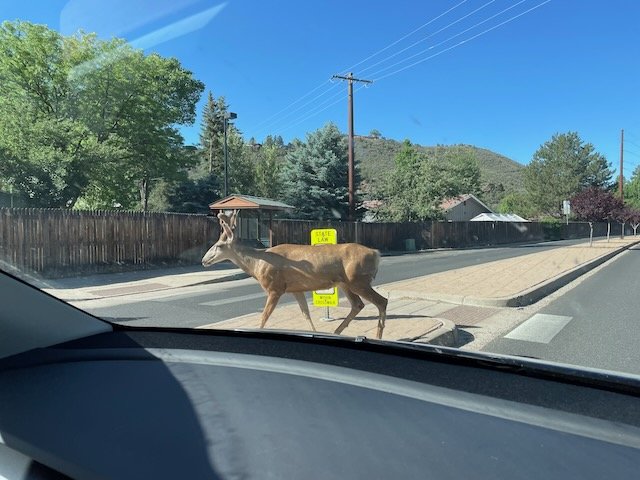It's weird. Much of the backlash against electric vehicles makes no sense. The other day a guy in a truck blasted an actual assload of exhaust at me. He was like a giant, frightened skunk trying to stink away my sedan bumping muffled National Public Radio. Maybe that is scary. Maybe I should take more time to understand the terrifying implications of Fresh Air's Terri Gross interviewing Angela Lansbury.
Sure, this dude could be dumber than his exhaust pipe, but I'll give him the benefit of the doubt. We've all been marketed the same line about being a real man in a real pickup, so he could be genuinely offended by what I represent: sacrifice. My pulling up in an electric whisper wagon is an apocalyptic sign of what he thinks I want him to give up. He might imagine that I want him to forsake his monster tires and wrap himself in a Nissan Leaf. He may think I want to raid his home and loudly declare each recyclable item in his trash. Ok, actually, that would be amazing. But that's not why I'm here.
My big thesis is that more efficient technology means that our sacrifice doesn’t have to be as much as one might think. At least right now, and for a limited time only, the things we need to do to keep the planet from killing us include some pretty exciting options. One day soon, yes, we might have to wrestle for water, so ¡ahora! seems like a good time to limit our emissions. What I'm about to reveal to you is that we took a road trip in an electric car with a family of five and it was amazing. As far as I could tell, we sacrificed very little and got somewhere around 150 miles per gallon. We also end up with some more play time, more free refills at Subway, free electricity from various townships, and coasted along in comfort with little anxiety about our range.
The American Road Trip is Not Dead
It starts in Littleton, which is just south of Denver. We finally get our Tesla Y. It's a long story about getting the car. I'll put it in a shaded box which, I think, suggests you can ignore it altogether and still get the gist of the article.
This is going to be an honest ride. I'll tell you the bad. For example, right now my car's creator Elon Musk is snorting dopamine out of the armpit of America's right wing. That hurts. He's supporting climate deniers who'd rather the world burn while they set alight shameless culture wars. That, and despite all the innovation put into transportation, cool cars with flat screens alone aren't going to save us for ourselves.
But it’s something. What’s happening in the auto industry with once-panned EV overtaking financial forecasts needs to happen in every industry. But this time without driving the innovators to Twitter-trolling madness. Musk enticed me with EV because they can be powered by whatever creates electricity. They can be plugged into the sun with solar power or into a stationary bike your grandma pedals while watching Love Island.
Day 1
We leave Littleton fully charged. Solar panels do their job. We're at 100% by simply plugging into the sky. If that sounds smug, eff it. It took me years to get to a point where this was possible. While we're gone, our home solar is going to feed the grid with enough electricity to power another household.
the sun is hot right now
and likely in perpetuity.
60 miles later, we're in Colorado Springs and at about 75% so decide to walk around a bit. We top off with a Tesla supercharger while our pedestrian experience turns into a full-fledged dining onslaught at the The Skirted Heifer. Their veggie burgers are amazing. Their burger burgers have all three kids raving at the same time. We bask in the rare glow of total family unanimity for so long that we get charged for charger idle fees. That’s a thing and likely going to become more contentious as electric units outpace infrastructure.
veggie burger
topped with a crap ton of irony.
We get to Pueblo with 78 percent. Not bad. My friend lets me plug into his garage for the night. It's your typical 110v house plug, but why not have the car fill up as you sleep? The cost to charge a Tesla Y is about 5 cents a mile. We added ten miles so I’ll tack that $.50 onto our total.
Total charge costs day 1 - $10.50
Miles traveled - 110
Day 2
One thing that can lean into deceptive territory is your EV's range. This math is likely calculated on a flat surface with a tailwind while driving solo and naked on an empty stomach. In real life, you have five people filled with pancakes who are clutching electric devices sucking the life source out of your vehicle. When you hit 80 on an interstate with a slight incline, you're going to gobble some power. Our 323-mile range was devoured to 240 in just a 48 mile trip.
This is when it gets tricky. We have a 70-mile detour to the Great Sand Dunes, which are totally worth it, and then another 50 miles to the amazing drive-in Movie Manor hotel in Monte Vista.
help your kids
get used to the future we’re making for them.
Theoretically, that should leave us with 120 miles of range. But we have a 132-mile drive to Durango the next day. We're definitely going to need to charge somewhere overnight. This is where the kindness of municipalities comes in. ChargePoint chargers are all over the country and they can add about 15-30 miles of range per hour. After a few hours you'll have about 60-70 miles of range and have spent around 5 bucks. But BUT (big, awesome but) in many towns, there are one or two that are on the house. While we watched the latest Top Gun on the big screen in the drive-in hotel, our car added 173 miles of range for $0.00. That's better than gold. You've filled up your tank lately. You know.
Charge costs day 2 - $0.00
Total Miles traveled - 300
Total road trip fuel costs - $10.50
Night 2
There are some tricks. Yes, that charger was free in Monte Vista (I just wrote the Monte Vista Journal a letter to the editor thanking the town for their generosity), but it comes with a price. It's a small one and, actually, quite good for you, but I had to walk. I dropped the car off at the charger and then hoofed it back to the hotel. Maybe just more than half a mile. Albeit through a cemetery that's kind of odd and beguiling in the daylight, but scary as hell at night.
The point is: yes, filling up your car with electricity can be much more of a commitment than swinging into a gas station. This is not a sacrifice, people. It’s an improvement. Now you might argue, “But, jackhole, what if I’m heading to work?” Is your work 300 miles across the state? If not, you should be fine.
Day 3
Here's the true magic of EV: mountain passes. Going up a hill that inspired 19th century cannibalism will also eat up your charge but, on the way down, you get about an equal amount of juice. On the east side of Wolf Creek pass we had 47%. After 20 miles of mountain driving, we were just one click lower at 46%. At that rate your EV has thousands of miles of range.
But reality sets in. You don't want to eff around with charge. So once we got to Pagosa, we ate some Subway while we charged about a hundred feet away. It was a big, fat, fast charger and, in about 30 minutes, we were at 100%. Six bucks.
From there we set off for Durango with the kind of confidence every Tesla owner wants you to believe they have: fully charged and in charge.
Charge costs day 3 - $6.00
Total Miles traveled - 432
Total road trip fuel costs - $16.50
Day 3-7
not going to torture
you with all the driving details during our stay in Durango, but here is a deer using a crosswalk.
Durango offers insight into the mishmash of current charging infrastructure. First, you have ChargePoint. This is a lovely effort that, over the past 15 years, has placed chargers all around the world. The app, however, does not always communicate well with your car. Sometimes it takes a few tries. You're just gonna have to breathe and dig deep for patience. And yes, they are a slower charge so it's a good time to plan a hike or eat a ridiculous breakfast (shout out to our buddy Pam at College Dr. Cafe). There are at least three other kinds of chargers you're going to encounter. The Tesla Supercharger is the queen.
Charge costs days 3-7 - $17.00
Total Miles traveled - 790
Total road trip fuel costs - $33.50
Day 8
This is the part where I share the secret to saving the world. It's in Poncha Springs, CO. Poncha is pretty much the center of the state (despite there being a town called Center sixty miles to the south) and it’s the damn bullseye for some future goals. Poncha is a gas station with an opportunity to turn to Salida, Monarch or Denver, but it also has a Tesla Supercharging Station. It's amazing. Gas. Tesla. Who gives a goddamn. Have a burger, both veggie and beef available.
That's magic. So if we have, for example, a growing existential crisis about to melt our asses into history, we don't have to make giant damn leaps to save the world. For now—I mean like right goddamn now—we get to make a choice. You don’t even need to be an asshole about it.
Look at this sign that looks like it was painted fifty years ago that states it plain as day.
oh, hey,
we’re all on the same team.
efficient cars
mean more money for snacks.
We pine for the days when things weren’t so fast paced while we desperately need to progress to a time when things are more sustainable. In the middle of America, with a promise of cheesesteak tethered to a chainlink fence, is the best of both worlds. A move towards a technological solution with a shady stop in road trip Americana. Route 66 electrified. Coal rollers and battery riders doing what humans used to be pretty good at: socializing. We’re always talking about finding common ground when in fact we have no choice but to share the same damn place. The ground is common whether we like it or not. Better make it good.
The 337 miles home took seven hours and fifteen minutes. That includes eating incredible burgers at the gas station and trying to find a place to pee on Wolf Creek.
Charge costs day 8 - $24.00
Total Miles traveled - 1127
Total road trip fuel costs - $57.50
Our final destination: where we met in Durango.













